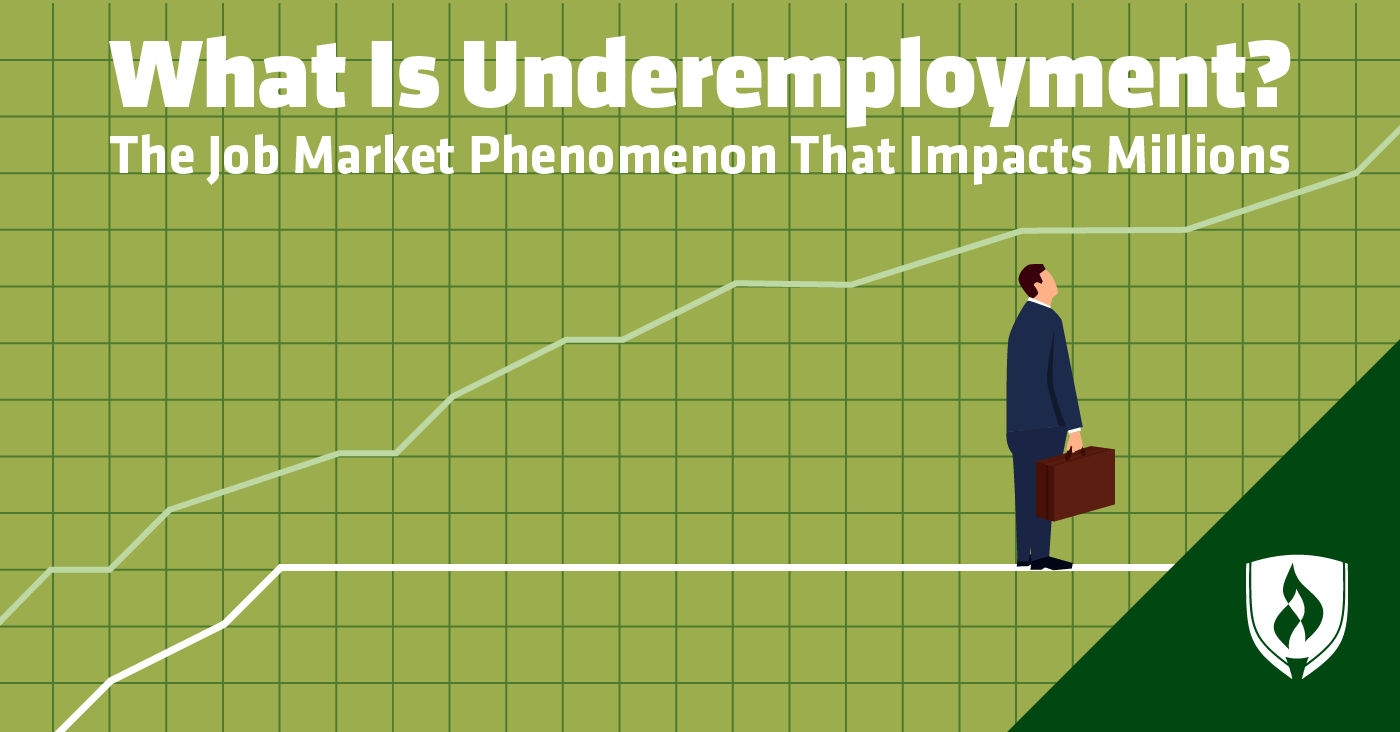What Is Underemployment? The Job Market Phenomenon that Impacts Millions
By Brianna Flavin on 04/08/2019
You may have been hearing conversation about a healthy job market in recent times. Maybe a family member told you that you should have no problem finding a job in today’s market—or that it will be easier for you when you graduate than it was for them.

Fingers crossed, of course. But oftentimes these sweeping statements about the economy are too comprehensively based around one statistic—the unemployment rate. The unemployment rate looks at the percentage of workers in the U.S. who are unemployed at a given time. Lately, that number has been historically low, causing lots of excitement for people who hope this signals a new era of prosperity.
But unemployment rates don’t paint a full picture. Even when a higher percentage of workers are employed somewhere, economists looking at many factors might still see signs of a troubled market. One of these trouble signs is underemployment.
What is underemployment, you ask? The first thing to know is that it’s nothing new. According to the Federal Reserve Bank of New York, about 33 percent of workers with a college degree have been underemployed at any given time in the last 30 years.1
Despite its longevity as a statistic we measure, underemployment rates don’t get the same attention as unemployment rates. But looking at this aspect of the labor market can help you understand what’s going on—and maybe even help you avoid a bad employment situation yourself.
What is underemployment, exactly?
Underemployment rates measure a few things, one of which is the number of people working jobs below their qualifications, from a bachelor’s degree and beyond. Underemployment also refers to people who are involuntarily working part-time or freelancing positions when they would prefer full-time employment.
“Underemployment is a situation in which a person is employed by an entity, but their contracted working hours are less than they wanted or needed,” says Charlie Worrall, digital marketing executive of Imaginaire Digital. Say you wanted to work a full 40 hours per week but your employer will only contract you for 35 hours a week, Worrall proposes. Those five hours per week start to add up, representing an income loss that builds up over time.
This situation is much harder to measure than national rates of unemployment. But its economic impact (not to mention its specific impact on a person’s life) is staggering. It represents college graduates who get stuck working the same food service jobs a year after graduation.
It also represents an in-between state where employees are working, sometimes with multiple jobs, but still struggling to make a living wage. Ideally, as employees gain experience, knowledge and efficiency in their fields over time, they should be able to earn a higher salary and grow into positions that reflect their abilities. When this trajectory is interrupted, underemployment looms.
How does underemployment happen?
There are thousands of personal reasons that contribute to individuals working in jobs that hold them back. But when underemployment becomes a theme in certain groups, industries or areas, there are larger factors at play.
“The biggest factor in underemployment is the labor market,” says global business consultant and author Philip La Duke. “In a tight labor market the demand for permanent, long-term employment with wages sufficient to live above the poverty line exceeds the number of jobs available.”
Another potential factor influencing underemployment right now, according to La Duke, is the delayed retirement of many in the large baby boomer generation. Employers who are feeling pessimistic about their business’s outlook may be putting off hiring new people, instead opting to convince older workers to stick around.
“We are now in the rarified position of having both a tight and loose labor market simultaneously,” La Duke says. This comes from employers looking for nearly impossibly qualified candidates for positions— “what recruiters call ‘unicorns’”—and often hiring older, more experienced professionals to fit the bill.
Even in a strong economy, employers who try to solve present-tense problems in their hiring choices, instead of training and developing employees into the people they need, can create conditions for underemployment.
“Contrary to popular belief, there is actually a shortage of talent in larger, more affluent city populations,” says Uma founder and CEO, Rita Kakati Shah. Shah explains that areas with lots of people might run into underemployment as employers cut hours for their existing employees to make room for specific positions. “This is especially true in factories and the trades.”
What is the potential impact of underemployment?
On the personal side of things, when people can’t work the hours they want or are held back in positions they are overqualified for—they don’t earn as much money as they should be earning.
“With both individuals and families struggling to work the hours necessary to keep themselves afloat, it’s likely that poverty levels will increase,” Worrall says. Worrall points out that when people are struggling to meet their essential needs and lose disposable income, the economy in general also takes a hit. Overworked, underutilized and underpaid employees don’t have as much room to go out for dinner or take vacations.
Or buy homes. La Duke says a long-term impact of a high percentage of underemployed workers is shrinking in the housing market. “People struggling to meet their basic needs are not likely to make a major investment like a home. They’ll instead live with their parents or share a rental property.”
The ripple effect of having a high percentage of underemployed workers stretches far and can eventually lead to higher rates of unemployment. But Shah points out that brief seasons of underemployment aren’t necessarily a bad thing on an individual level. “When we place experienced candidates back into work, quite often they are too qualified for the roles available,” Shah says. “But they need a little time to retrain or refresh their skills.”
Because of the rapid growth and change in many fields, Shah emphasizes that professionals might frequently take a slightly lower position than their credentials would signify—to ensure that they understand and can perform the job before advancing.
Maximizing your opportunities for meaningful employment
It’s easy to misunderstand an underemployment situation when you are in one. But some professionals might avoid underemployment by looking for employers that invest in their hires and think toward the future.
Another way to maximize your opportunity is to understand what the workforce needs and what today’s employers are looking for. Check out “What Are ‘New-Collar’ Jobs? Understanding the Current Demands of the Workforce” to see whether your goals line up!
1Federal Reserve Bank of New York, Current Issues in Economics and Finance, Are Recent College Graduates Finding Good Jobs? [accessed March 2019] https://www.newyorkfed.org/medialibrary/media/research/current_issues/ci20-1.pdf




